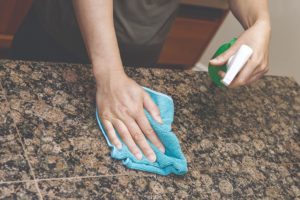
Natural stone and tile, such as marble, granite, limestone, travertine and slate, make for beautiful counter tops and floors, and they’ll last for many, many years. However, these surfaces require a little regular care to ensure they stay in top shape for many years to come. We’ve compiled a few tips on how to clean stone and tile, the best stone cleaners and even how to tell when it’s time to reseal your stone. Read on for our top tips and tricks.
Protect the finish
Avoid causing issues for yourself (and your natural stone) by protecting the finish. If the finish is protected, then the natural stone and tile will be protected. Clean stone surfaces regularly and try to avoid anything that will scratch the surface — have your spouse remove dirty shoes outside to keep dirt and sand out, and avoid shoes like sharp high heels or soccer cleats with pointed soles.
Don’t be harsh
When you pick a cleaner, choose something mild and natural. Avoid harsh cleaners such as creams with abrasives or bleach. These break down the sealer and leave your stone unprotected. Specifically avoid products with lemon, vinegar or other acids. DO NOT mix cleaning products, and read all labels carefully. See our recommendations for products here.
Address the issues
Once you see an issue, it’s time to do something about it! Be it a deteriorating sealer or a build-up of dirt, once you notice these, deal with them immediately. Don’t allow the problem to worsen. For this reason, you should dust and mop often to avoid issues.
Testing, testing!
The best way to ensure a cleaner is right for your floor or counter (besides reading the instructions) is to test in a small, non-obtrusive area. This way, if something does happen, it’s a small area that won’t be too noticeable.
Take preventative steps
The best way to fix issues is to prevent them before they start. Protect your floors with area rugs or mats to avoid excess exposure. In addition, don’t forget to reseal whenever appropriate. How do you know when it’s time to reseal your natural store? There’s a simple test — flick a little bit of water onto the floor with your fingertips. If the sealer is still strong, the water will “bead” on the surface of the stone. However, if it splatters or soaks into the stone, it’s time to re-seal the stone surface.
